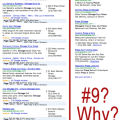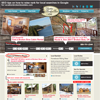Take your run-of-the-mill SEO from ho-hum to the next level
Years ago getting that #1 rank was easy. But things have changed. Competition has increased. And anyone in the internet marketing field has learned the basics with most all of them saying “they do SEO.” Even business owners are doing it. So now to get Google’s attention – and, more importantly, your customer’s attention – you have to step it up.
I gave this talk at the Santa Cruz WordPress Meetup group in September, 2013. These are certainly not all the SEO techniques you should be implementing, but here are a few that address the ho-hum approaches that everyone is doing now.
Slide notes follow.
- –
- A few things everyone is doing, while still important, are overused and usually (more on that later) no different than anyone else is doing.Keywords
- “Boring” keyword inclusion does not keep the consumer in mind. Words are chosen using a keyword research tool based on what Google says are popular, and less about what YOUR customers want. Sometimes they are the same; sometimes not. The focus is wrong.
- “Boring” keyword stuffing again has no consideration for the consumer. Page is stuffed with keywords to get Google’s attention but is a turn-off to readers. This is very common, worse than ho-hum from consumer perspective.
- Better keyword inclusion writes first for the consumer.
- Instead of looking for the most searched keywords, think first about your audience. That begins with identifying your target market and their needs. Who are they? What is their pain? What are they searching for? Download Messaging Framework and fill it out.
- Example: vanilla.com. Identify offer first. In their case, it’s high-quality, more expensive, vanilla products in volume.
- 1st challenge: To sort out those who are looking for vanilla products in volume. Goal is to find keywords that will segment them out in queries and then SELL them once they land on the page.
- 2nd challenge: Find those willing to pay extra for better quality. Look for other characteristics that might justify higher cost like eco-friendly, fair trade, etc.
- Identify who meets that criteria. In this case, that would be bakers, ice cream makers, professional chefs AND home enthusiasts who love to bake and bake a lot, as well as those who are passionate about saving the planet and helping humanity (fair trade).
- Bakers would be one target.
- What keywords would a baker use looking for large quantity?
- Answer: “bulk,” “wholesale,” “quantity discount.”
- A baker might also search for high quality using: “best vanilla,” “best quality vanilla,” “vanilla reviews,” etc.
- Your target market might also be on a very different keyword branch. For example, bakers might be looking for new recipes to use up all the vanilla beans they bought, or they want to inspiration for a new vanilla recipe. So target other branches they might be on such as “recipes” and “dessert recipes.”
- Also get specific for queries on that branch that would target your products such as “vanilla recipes,” “vanilla extract recipes,” “vanilla bean recipes” and…
- other products such as “vanilla paste recipes”
- Target your other market segments. In this case that would be those who look for eco-friendly products. In this case, we did the keyword research and found that no one is looking for eco-friendly vanilla or sustainably grown vanilla, but they do look for organic vanilla. Using the “other branch” approach though, we could target “eco-friendly products” and “eco-friendly businesses” to attract those people for other keyword queries. Most people use vanilla, so they could become our customers, but the competition may be so great that our time would be better spent elsewhere.
- Another segment would those who are socially conscious. What keywords would they use? “fair trade vanilla” is the most obvious in this case. We could go down other branches, but this phrase will be the most lucrative.
- So what did we do?
- Do keyword research first. We used Google’s keyword planner, Google Trends, UberSuggest, Google’s recommended keywords that you’ll see at the bottom of any search results page under the title “Searches related to…, and finally, ask your customers. Take notes when you get phone calls. Many say, “Do you do [blank]?” Those are important keywords for you.
- Using your keyword list, imagine people using them in search queries, and build pages for them, to answer their questions, solve their problem, etc. Only target 1 keyword phrase concept per page. For example…
- We built pages for PEOPLE looking to find “bulk vanilla beans” and “wholesale vanilla,” as well as…
- PEOPLE looking to find the “best vanilla extract” and “fair trade vanilla.” Note: vanilla.com does not sell fair trade vanilla; they sell “fairly traded” vanilla, so we could direct them to the store page for fair trade vanilla. Instead we created a controversial piece to capture the attention of those wanting to buy fair trade vanilla. Those looking to buy might think twice when they see our title in the SERPs roundup. Then once we get them to the page, we sell them what they really wanted in the first place – vanilla that gives the farmers a fair wage.
- Over time, add more keywords and keyword branches. Start with the low hanging fruit and the keywords that target those further along in the buying process as long as those aren’t out of reach with your budget and competitively.
- Use this Google Drive spreadsheet to create an outline for your website so that you are clear what each page should be about, who you are writing for, what you’re trying to accomplish and more. It will help prevent keyword cannibalization where two pages compete for Google’s attention.Metatags
- Metatags are often ho-hum. Everyone knows to use them and too often target Google and not people.
- Meta descriptions show up in the search results. This is your chance to shine, to stand out in the crowd, and convince the searcher to click over to your website.
- Very ho-hum example. So what? Yes, I know you’re a professional organizer. You wouldn’t have come up in a query if you weren’t. Tell me something I don’t know. Tell me something you want me to know.
- These examples catch my attention. They also tell me you understand my pain and they tell me what I’m going to get if I call you (less stress and anxiety for example). They also tell me a bit about your personality and that you have a sense of humor and that you are approachable.
- Ho hum again. The “free consultation” value proposition is there though, but is it enough? How does that compare to competition.
- Nice messaging in this example. Tells me more ABOUT this attorney and there is the claim he can get me compensation.
- But this one really works. They tell me what they did in numbers. I’m impressed.
- Google created their own descriptions. So all your hard work in carefully crafting your descriptions might be for naught. Why does Google do that? Because it’s looking for the keywords used in the query. If they are not in the meta description, it will pull them and surrounding text from the page itself. So use the spreadsheet to tell you what keywords and PEOPLE you are targeting and include the right keywords in the description as well.
- Those weren’t the best descriptions, but Lori was the only one on the page for that keyword query, so don’t worry about it. When your competitor is there, though, it does matter. Be sure to use city names as well when you’re trying to target local keyword queries.
- Summary is self explanatory.
- Metatitles are extremely important for ranking. Here I put targeting Google ahead of targeting people. But still try to avoid the ho-hum. Make them attention getting IF POSSIBLE but also make sure the searchers will see them as relevant. Because the use of keywords is so important and you have so few characters, these are harder to not make Ho-Hum for things like product and service pages, but for blog titles you can and should be creative. Always include keywords and try to put them first if possible.Schema Code Markup
- –
- Schema code markup is widely used to send clear, identifying information to search engines so there is no guessing about who you are, what you do, what you sell, where you are, and much more.
- According to Searchmetrics, schema improves rank.
- It certainly improves how you look in the search results. See examples.
- Example of code.
- “
- WordPress has several plugins that generate it automatically for you.
- Or you can use microdatagenerator.org to do that and then just copy and paste code where you want it on your site.#1 most forgotten SEO technique to improve your rank
- Just as links get people and Google from one page to another, they also tell people and Google what that page is about with use of keyword anchor text, close-proximity keywords, and other relevancy on the page.
- We all know backlinks coming from other sites improve rank, internal linking helps to because it sends relevancy and “I’m important” signals to Google. Google understand better what a page is about and how important is within the site. If you have a lot of pages within your site linking to a single page about “vanilla beans,” for example, Google will conclude that page has a lot of information about vanilla beans and may be very relevant to someone’s query.
- Site architecture is important. Set up your site so that internal links will go primarily to top-tier pages. Your goal is to develop pages on your site that get lots of internal links on your most important keywords.
- Link on keywords. While this is frowned upon for external backlinks, Google says this is ok internally. Just don’t overdo it.
- Summary
- The most forgotten SEO tactic is…
- Internal linking to NEW pages. After you write a new blog or add a new page, find other pages on your site where you can add an internal link TO it. Your spreadsheet will help!
Latest posts by Kat (see all)
- How to reclaim ownership of your Facebook business page - May 7, 2025
- How to get reviews using QR codes and boost your rank in Google - November 14, 2023
- How to Improve Behavioral Signals on Your GBP to Help Rank - May 14, 2023







